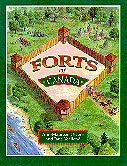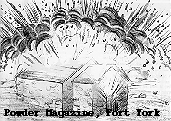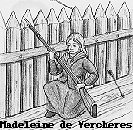


|
Forts of Canada.
Ann-Maureen Owens and Jane Yealland. Subject Headings:
Grades 3 - 6 / Ages 8 - 11. ***1/2 /4
|

excerpt:
Stuart Fraser curses that day in 1810 when he signed on with the North West Company to run their trading post, Rocky Mountain House in Alberta. His room is so cold that his ink has frozen and the inside log walls are covered with frost. The storm last night blew down part of the wooden palisade surrounding the post, but he and his three partners are too hungry to repair it. The last of their dried meat, called pemmican, is gone and unless they have some luck hunting, the only things left to eat are their leather shoes.
 Forts of Canada is a great little history book for primary-aged school children. They will learn that from sea to shining sea the fort has always been an integral part of Canada's history. They will discover that not only soldiers built forts; Canada's forts were built by different kinds of people, served various purposes and many became our modern Canadian cities.
Forts of Canada is a great little history book for primary-aged school children. They will learn that from sea to shining sea the fort has always been an integral part of Canada's history. They will discover that not only soldiers built forts; Canada's forts were built by different kinds of people, served various purposes and many became our modern Canadian cities.

Authors Ann-Maureen Owen and Jane Yealland follow a chronological path through the long history of forts in Canada. They tell us that before Europeans arrived on our shores, the First Peoples of the Atlantic region, the Eastern forests and the Pacific coast range built palisade fortifications to protect themselves from enemies. Later, the French explorers' first priority was to build rough defensive fortifications against the British and Iroquois. Soon, black-robed Jesuit missionaries were building forts deep in the wilderness. Fur traders from the Hudson's Bay and NorthWest Company built trading posts and forts in the Arctic's hostile environment, in the mosquito-infested muskeg swamps of the Boreal forest, in the wind swept western plains and in the passes of the mighty Rocky mountains. Settler and police forts followed in the 19th century and military forts were still built in the 20th century. Many forts still exist in Canada today, but they do not play an important role in Canadian life. They are now museums and monuments to our heritage.
Forts of Canada is a book little kids will love. It incorporates many great hands-on activitieslike how to build a Huron fortified village or a western whiskey trader's fort and there are semaphore instructions and bannock and fruit roll-up cooking lessons as well. There are also tales of bravery, hardship, and villains meeting their just rewards.
This book will be a valued aid and addition to planning and teaching primary units on early times in Canada and Native Studies. The book contains a short glossary of terms, a map of forts you can tour today in Canada, and an index. Teachers need not use non-Canadian, non-historical materials to teach these units when superb 100% Canadian content and history can be found in books like Forts of Canada.
Highly Recommended
Ian Stewart works at Lord Nelson School and at the University of Winnipeg Library.

To comment on this title or this review, send mail to cm@umanitoba.ca.
Copyright © 1996 the Manitoba Library Association. Reproduction for personal use is permitted only if this copyright notice is maintained. Any other reproduction is prohibited without permission.
Published by
The Manitoba Library Association
ISSN 1201-9364
AUTHORS |
TITLES |
MEDIA REVIEWS |
BOOKSHELF
BACK ISSUES |
SEARCH |
HOME